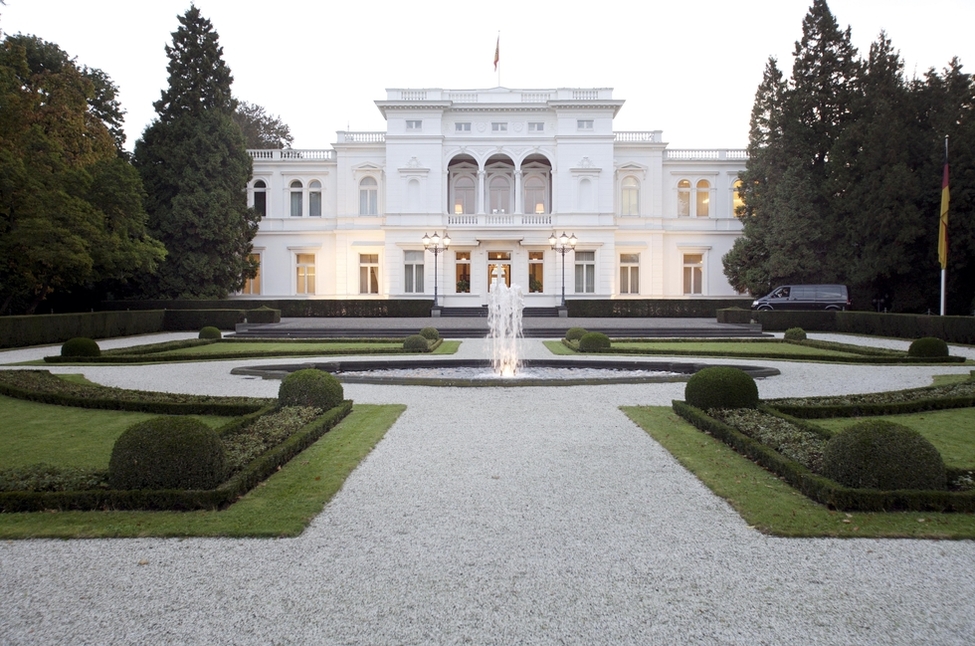The Villa Hammerschmidt in Bonn has been the Federal President’s official residence since 1950. Situated on the banks of the Rhine next door to the Palais Schaumburg, the Federal Chancellor’s office in Bonn, the Villa is right at the heart of the old Federal capital. Over more than 40 years as the Federal President’s primary official residence, the Villa Hammerschmidt became a symbol of the fledgling democracy that was the Federal Republic of Germany. State guests, politicians, artists, writers and representatives of all areas of society have gathered there.
In 1994, Federal President Richard von Weizsäcker decided to move the head of state’s main residence to Schloss Bellevue in Berlin. Since then, the Villa Hammerschmidt has been the secondary official residence of the Federal President. When the President is in residence, the Presidential Standard flies over Villa Hammerschmidt.
From "Sugar Palace" to "Bonn's White House"
The Villa Hammerschmidt in Bonn can look back on some 150 years of history. Bonn architect August Dieckhoff built the Schinkel-inspired villa in around 1860 for the merchant Albrecht Troost. In 1868 Troost sold the house to Leopold Koenig, a Russian Imperial State Councillor, who had made a considerable fortune as a sugar manufacturer in St Petersburg. In 1878 Koenig had the building remodelled and extended by the architect Otto Penner.
The Villa was purchased in 1899 by Rudolf Hammerschmidt, a Prussian Privy Commercial Councillor. He too came to Bonn from St Petersburg, having made his fortune in the cotton industry. During this time the Villa Hammerschmidt served as a centre for Bonn's high society. Following Rudolf Hammerschmidt's death, his son-in-law Ernst Poensgen acquired the property in 1928 and allowed the Villa to be leased and divided into apartments. The entire art collection and all the furniture was auctioned off.
The Villa survived the Second World War unscathed. It was requisitioned in 1945 by the Allied occupying powers and returned at the end of 1949.
The Federal Republic of Germany purchased the property on 5 April 1950 from the heirs of Rudolf Hammerschmidt. The Villa was designated the official residence of the Head of State. At the end of 1950, Theodor Heuss became the first Federal President to move into the Villa, which served as his official and private residence.
Since then the neoclassical building has been converted and renovated several times. On the top floor are the Federal President's private apartments. Rooms used for official gatherings, like the grand hall, the fireplace room, the dining hall and the terrace room, are located on the ground floor.
Nearly all Heads of State and Government, many of them royalty, have visited the Villa Hammerschmidt on the Rhine in the years since 1950.

The Villa Hammerschmidt also served as the official residence for Theodor Heuss's successors, many of whom lived there too. The Federal Presidents who resided here were Heinrich Lübke, Gustav Heinemann, Walter Scheel, Carl Carstens, Richard von Weizsäcker and Roman Herzog, who moved to the new capital, Berlin, during his term of office.
Some of the Villa's current furnishings and artworks are owned by the Federal Government, others are on loan from the Länder and from museums throughout the country. The furnishings, 1830s French Empire, come from Schloss Wilhelmshöhe in Kassel.
The paintings and photographs are on loan from the Museum Ludwig in Cologne, the August Sander Archive at the SK Culture Foundation in Cologne and the artist Karl Otto Götz.
The art collection also includes works by Bernard Schultze (1915–2005) and Karl Otto Götz (1914–2017), who were two of the founding members of the "Quadriga" group of artists in 1952. As representatives of the "informal art" movement that developed out of abstract painting and expressionism, they shaped the post-war German art scene and helped open it up to the world again.
The famous portraits by photographer Hugo Erfurth (1874–1948) have become part of our collective memory due to their sober style and exclusive focus on the subject’s face. August Sander (1876–1964) is regarded as one of the most renowned German photographers. His works include portrait, landscape, architectural and industrial photography.
Villa Hammerschmidt
Address
Kaiser-Friedrich-Straße 1653113 Bonn
Germany


